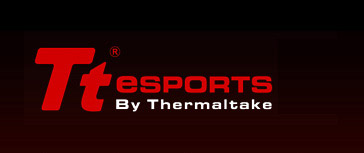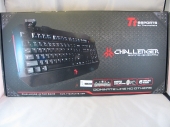Introduction
E-sports is one of those trends that has come and gone over the past decade, as interest waxes and wanes. With the prominence of StarCraft II, League of Legends and other e-sports-minded games on the rise, many companies are looking to get in on the action with e-sports branded and themed peripherals. Thermaltake is so jazzed about the idea, they spun off a separate imprint for the purpose, Tt eSPORTS. Under that label, they’re putting out a fairly broad range of keyboards, mice, headsets, mousepads, and other gaming accessories. Today we’ll be taking a look at the entry level keyboard in this new lineup, the Tt eSPORTS Challenger.
Features
First, let’s take a brief look at the features Tt is touting for this keyboard, as well as my commentary on them. All feature text is taken verbatim from manufacturer-provided materials.
| Feature | Commentary |
| 32 KB On Board Memory – Storage up to 18 macro keys for FPS, MMORPG RTS and more games. | A fairly standard amount these days for macro-capable peripherals |
User interface –
|
Apparently the manual is bleeding over into the feature text. We’ll comment on the user interface itself when we get to A Closer Look below. |
Macro keys -Macro key setup Gamers can program their personalized key contents via keyboard
|
More bleed-over from the manual. |
| Multimedia Keys – Instant access to multimedia function for quick audio control | A fairly standard array of media control keys, accessed through a Fn+key chord. On-keyboard volume control is nice; whether the play/pause/stop/skip buttons will be picked up by your music player while in-game is up to the software. |
| USB 2.0 Port – Provide easy usage of other USB peripherals | “Peripherals” is a bit of a misnomer; there’s only one port on this keyboard. |
| On Board Profile Switch – On board profile switch to engage for instant game changes | Also accessed through a Fn+key chord, this lets you switch profiles without having to alt-tab to the desktop and hunt down the configuration software. A standard key profile with no macros is also immediately available; handy if you find your profiles stomping on an important key binding. |
| Fan Device – Cooling Fan not only keeps your hand dry and provides comfortable gaming experience | A dubious claim at best; I don’t think I’ve ever heard of someone suffering from sweaty-back-of-hand while gaming. |
| Windows Dummy Keycaps – Enclosed with two Windows keys to disable the function; prevent from jumping out of the game by accident | A nice enough gesture; unfortunately rendered pointless by the lack of a left-hand Windows key. |
| Smart Cable Management – Protects cable from damage of improper use | In lieu of proper strain relief molding on the cable itself, Tt eSPORTS has instead given us this short cable channel that moves the cable 2″ to the right. |
A Closer Look
Set against a steel floor panel with rivets in the corners, this box is clearly meant to say “this product is tough”. As always, the proof is in the testing.
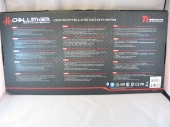 On the back, Tt has elected to give us four feature bullet points in fifteen languages…and that’s it.
On the back, Tt has elected to give us four feature bullet points in fifteen languages…and that’s it.
 Inside, surrounding the driver CD, we get the feature breakdown that should have been on the back.
Inside, surrounding the driver CD, we get the feature breakdown that should have been on the back.
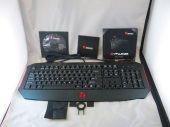 Laying it all out, we have the keyboard itself, driver CD, warranty pamphlet, key puller, two dummy keycaps and a fabric pouch that holds said keypuller and keycaps.
Laying it all out, we have the keyboard itself, driver CD, warranty pamphlet, key puller, two dummy keycaps and a fabric pouch that holds said keypuller and keycaps.
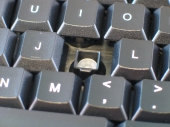 Putting that keypuller to work, I yanked off one of the keys to see what kind of switch mechanism this keyboard uses. Unsurprisingly, I found a standard rubber dome switch, as you’ll find on most cheap keyboards, including that one that came with your mom’s old Dell or HP. Given this, I think the manufacturer’s durability estimate of 10 million keystrokes is wildly over optimistic.
Putting that keypuller to work, I yanked off one of the keys to see what kind of switch mechanism this keyboard uses. Unsurprisingly, I found a standard rubber dome switch, as you’ll find on most cheap keyboards, including that one that came with your mom’s old Dell or HP. Given this, I think the manufacturer’s durability estimate of 10 million keystrokes is wildly over optimistic.
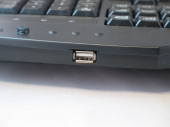 On the back of the keyboard, I found the lone USB port. It works well enough with mice and other low-power peripherals, but flash drives refused to function.
On the back of the keyboard, I found the lone USB port. It works well enough with mice and other low-power peripherals, but flash drives refused to function.
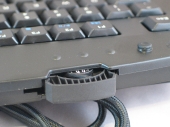 Opposite the USB port on the back was a curious bit of plastic protruding from the housing. Looking closer, I realized that this was the advertised Fan Device. Experimentation proved that yes, it really is meant to hang halfway out of the slot like that when not in use.
Opposite the USB port on the back was a curious bit of plastic protruding from the housing. Looking closer, I realized that this was the advertised Fan Device. Experimentation proved that yes, it really is meant to hang halfway out of the slot like that when not in use.
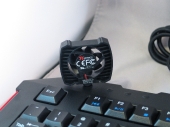 In use, the fan is meant to plug into either of the rubber-cap-covered holes at the top corners of the keyboard’s face. While the idea works in theory, the lack of any place to store the caps while the fan is in use means you’ll probably lose them quickly.
In use, the fan is meant to plug into either of the rubber-cap-covered holes at the top corners of the keyboard’s face. While the idea works in theory, the lack of any place to store the caps while the fan is in use means you’ll probably lose them quickly.
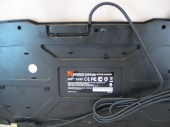 The only feature of note on the bottom is the cable channel. Unlike those found on other gaming keyboards, this channel is not meant to redirect the cable to the side of the keyboard for ease of positioning. Rather, it serves in place of strain-relief molding, presumably to keep you from yanking the cable loose of its PCB mount in a fit of nerd rage. Unfortunately, the position and shape of the channel conspire to ensure that the cable will pop free of it with only mild encouragement.
The only feature of note on the bottom is the cable channel. Unlike those found on other gaming keyboards, this channel is not meant to redirect the cable to the side of the keyboard for ease of positioning. Rather, it serves in place of strain-relief molding, presumably to keep you from yanking the cable loose of its PCB mount in a fit of nerd rage. Unfortunately, the position and shape of the channel conspire to ensure that the cable will pop free of it with only mild encouragement.
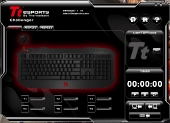 As is the norm for macro-capable input hardware, setup is achieved via an included driver program. Basic keyboard functionality is available sans drivers, but if you’re putting down extra money on a macro-capable keyboard, one presumes you want to make some macros. Once you have the macros set up and saved to the keyboard’s memory, you can then swap the keyboard to other systems while retaining the programming.
As is the norm for macro-capable input hardware, setup is achieved via an included driver program. Basic keyboard functionality is available sans drivers, but if you’re putting down extra money on a macro-capable keyboard, one presumes you want to make some macros. Once you have the macros set up and saved to the keyboard’s memory, you can then swap the keyboard to other systems while retaining the programming.
 From here you can do the macro programming, switch profiles, control the lighting on the Tt logo in the palm rest, register for warranty service (?), run a timer (??), and manage saved profiles. In an apparent attempt to be as language-neutral as possible, very few of the buttons and controls have any kind of descriptive labeling, relying instead on icons to get the point across. Ironically, this made the software harder to figure out than any amount of broken English labeling. The actual macro-assigning process requires you to click on one of the T buttons below, click on a keyboard key on the diagram above–which has unhelpfully been stripped of any keycap labels you might have used to pick out the key you wanted from its neighbors–then choose MACRO from the drop-list next to the T key you clicked initially. As you may have noticed, for all the talk of T keys this keyboard has no actual dedicated macro keys. You are instead encouraged to pick out an ordinary key from the standard layout, which is then remapped to fire your macro.
From here you can do the macro programming, switch profiles, control the lighting on the Tt logo in the palm rest, register for warranty service (?), run a timer (??), and manage saved profiles. In an apparent attempt to be as language-neutral as possible, very few of the buttons and controls have any kind of descriptive labeling, relying instead on icons to get the point across. Ironically, this made the software harder to figure out than any amount of broken English labeling. The actual macro-assigning process requires you to click on one of the T buttons below, click on a keyboard key on the diagram above–which has unhelpfully been stripped of any keycap labels you might have used to pick out the key you wanted from its neighbors–then choose MACRO from the drop-list next to the T key you clicked initially. As you may have noticed, for all the talk of T keys this keyboard has no actual dedicated macro keys. You are instead encouraged to pick out an ordinary key from the standard layout, which is then remapped to fire your macro.
 Going through this initial three-step process lands you here, where you can record a sequence of keys to be macroed. For some inexplicable reason, the Load and Save keys are greyed out when you first access this screen, meaning that you cannot load any macros you had previously saved to file on your system.
Going through this initial three-step process lands you here, where you can record a sequence of keys to be macroed. For some inexplicable reason, the Load and Save keys are greyed out when you first access this screen, meaning that you cannot load any macros you had previously saved to file on your system.
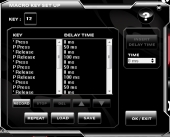 After recording a macro, suddenly the Load and Save buttons become usable. It’s nice to know the load-from-file functionality is actually present, but this method of accessing it is counter-intuitive and cumbersome. As for the macros themselves, I was able to record fairly long spell sequences from Magicka without running into any limitations.
After recording a macro, suddenly the Load and Save buttons become usable. It’s nice to know the load-from-file functionality is actually present, but this method of accessing it is counter-intuitive and cumbersome. As for the macros themselves, I was able to record fairly long spell sequences from Magicka without running into any limitations.
Benchmarks
“Benchmarks,” you ask, “for a keyboard?” Yes, it is possible to do such a thing. A keyboard is a fairly simple device in concept, but implementation details can make the difference between one that “just works” and one that “just sucks”. All tests were performed with the following setup:
| CPU | Intel Core i5 2300 |
| Motherboard | MSI P67A-GD80 |
| Operating System | Windows 7 Ultimate, SP1 |
| Keyboard 1 | Tt eSPORTS Challenger |
| Keyboard 2 | Filco Majestouch Tenkeyless Otaku (Cherry Brown keyswitches) |
Our comparison keyboard, the Filco Majestouch, can function in either PS/2 mode or USB mode. Since the Challenger is USB only, we plugged in the Majestouch in USB mode for all tests.
Credit Card Test
This first test is one that anybody can do at home, it requires only a text editor–Notepad will do nicely–and a credit card, library card, or any similar stiff rectangle of plastic. Holding the card above a row of keys with one corner slightly lower than the other, you simply bring the card straight down, guillotine-style, on a row of five keys. If everything is working as intended, you’ll see the letters for the keys you hit, in the order you hit them. If everything is not ok, you may see transposed letters, missing letters, or letters you never even hit. RTS or MMO players who are used to doing “piano-rolls” will appreciate the need for this kind of accuracy.
For this test, I focused on the left-hand side of the keyboard, where you’re likely to use it during gaming sessions. I deliberately chose sequences of five keys, as that is the most you could reasonably expect to piano-roll even with deliberate fat-fingering. Each row is a set of five trials for each key set. I tried each set in left-to-right and right-to-left patterns. Trials where the card slipped were repeated, but the results are otherwise unedited.
| Tt eSPORTS Challenger | Filco Majestouch |
| 12345 12345 12345 12345 12345 | 12345 12345 12345 12345 12345 |
| 54321 54321 54321 54321 54321 | 54321 54321 54321 54321 54321 |
| qwert qwert qwert qwert qwert | qwert qwert qwert qwert qwert |
| trewq trewq trewq trewq rtewq | trewq trewq trewq trewq trewq |
| werty weryt werty werty werty | werty werty werty werty werty |
| ytrew ytrew ytrew ytrew ytrew | ytrew ytrew ytrew ytrew ytrew |
| asdfg asdfg asdfg asdfg asdfg | asdfg asdfg asdfg asdfg asdfg |
| gfdsa gfdsa gfdsa gfdsa gfdsa | gfdsa gfdsa gfdsa gfdsa gfdsa |
| sdfgh sdfgh sdfgh sdfgh sdfgh | sdfgh sdfgh sdfgh sdfgh sdfgh |
| hgfds hgfds hgfds hgfds hgfds | hgfds hgfds hgfds hgfds hgfds |
| zxcvb zxcvb zxczb zxcvb zxcbv | zxcvb zxcvb zxcvb zxcvb zxcvb |
| bvcxz bvcxz bvcxz bvcxz bvcxz | bvcxz bvcxz bvcxz bvcxz bvcxz |
| xcvbn xcvbn xcvbn xcvbn xcvbn | xcvbn xcvbn xcvbn xcvbn xcvbn |
| nbvcx nbvcx nbvcx nbvcx nbvcx | nbvcx nbvcx nbvcx nbvcx nbvcx |
The Challenger held up reasonably well in this test, only showing occasional transposition errors. Anyone not used to pumping out 150+ APM in Starcraft will likely not notice.
3KRO Test
For this test, I went through every combination of three simultaneous key-presses I could think of that left-handed and right-handed gamers might conceivably use. Below is a list of combinations that did not work with this keyboard. No extra, or “ghost” key-codes were generated by these combinations, but when two of the keys were pressed, the third would simply not register.
Left hand chords
tilde+tab+1 – many of these tilde+tab+ combinations would cause the tab key to “stick down”, so that the controller would continue to send the key-code repeatedly until I tapped the tab key again.
tilde+tab+2
tilde+tab+3
tilde+tab+4
tilde+tab+5
tilde+tab+6
tilde+tab+q
tilde+tab+w
tilde+tab+e
tilde+tab+r
tilde+tab+t
tilde+tab+a
tilde+tab+s
tilde+tab+d
tilde+tab+f
tilde+tab+g
tilde+tab+z
tilde+tab+x
tilde+tab+c
tilde+tab+v
tilde+tab+spacebar
tilde+capslock+g
tilde+1+z
tilde+2+x
tilde+3+c
tilde+4+spacebar
tilde+5+v
tilde+lalt+f1
1+f1+lalt
1+2+x
1+2+z
1+3+c
1+3+z
1+4+z
1+4+spacebar
1+5+v
1+5+z
1+6+r
1+6+z
2+3+c
2+4+x
2+4+spacebar
2+5+v
2+5+x
2+6+r
2+6+x
3+6+r
3+6+c
4+6+r
4+6+spacebar
5+6+r
5+6+v
1+q+z
1+w+z
1+e+z
1+r+z
1+t+z
1+a+z
1+s+z
1+d+z
1+f+z
1+g+z
1+x+z
1+c+z
1+v+z
1+spacebar+z
2+q+x
2+w+x
2+e+x
2+r+x
2+t+x
2+a+x
2+s+x
2+d+x
2+f+x
2+f+z
2+g+x
2+g+b
2+z+x
2+x+c
2+x+v
3+q+c
3+w+c
3+r+c
3+t+c
3+t+v
3+a+c
3+s+c
3+d+c
3+f+c
3+g+c
3+g+b
3+z+c
3+x+c
3+c+v
4+q+spacebar
4+w+spacebar – No jumping while running forward and switching weapons?
4+e+spacebar
4+r+spacebar
4+t+spacebar
4+a+spacebar
4+s+spacebar
4+d+spacebar
4+f+spacebar
4+g+b
4+g+spacebar
4+g+capslock
4+z+spacebar
4+x+spacebar
4+c+spacebar
4+v+spacebar
5+q+v
5+w+v
5+e+v
5+r+v
5+t+v
5+a+v
5+s+v
5+d+v
5+f+v
5+g+v
5+g+capslock
6+q+r
6+w+r
6+e+r
6+r+t
6+r+a
6+r+s
6+r+d
6+r+f
6+r+g
6+r+z
6+r+x
6+r+c
6+r+v
6+r+spacebar
6+r+tab
6+g+b
6+g+capslock
q+w+h
q+f+lalt
w+e+h
w+f+lalt – Many people choose to bind their push-to-talk key to left alt, however this will not work well in practice with this keyboard.
e+f+lalt
r+f+lalt
t+f+lalt
a+f+lalt
s+f+lalt
d+f+lalt
f+z+lalt
f+x+lalt
f+c+lalt
f+v+lalt
g+b+tilde
right hand chords (all done with numlock on)
up+left+numslash
up+down+num7
up+down+numstar
up+right+num4
up+right+numminus
left+down+num8
left+right+num5
left+right+numplus
down+right+num6
Some of these key combinations are improbable, but many are not, especially for MMO or RTS gamers. With this many 3KRO errors, I felt a 4KRO test unnecessary, as these combinations would not work any better with more keys pressed. The problems with left Alt are especially troubling, given that one can usually count on the modifier keys (ctrl, shift, alt) to not ghost.
Our comparison board, the Filco Majestouch, did not exhibit any of these problems, registering every key combination I could think of without error.
Thoughts and Conclusion
It’s clear that Tt doesn’t want to leave budget-minded gamers out of the loop with their latest line of gaming peripherals, however those two opposing goals–high performance and low cost–leave this product as something of a mixed bag. The macro functionality and almost-no-drivers-required setup are certainly nice for people who spend a fair amount of time gaming on PCs not their own–not terribly uncommon for people who participate at tournaments or game at Internet cafes. That said, the baffling user interface makes getting those macros set up a chore.
Typing on this keyboard was about what you’d expect for a membrane keyboard, not noticeably stiff or mushy. In the interest of full disclosure, I’ve been using mechanical keyboards for years now and have become totally spoiled by them. Impressions gathered from others on this topic ranged from “meh” to “it’s decent”.
The braided cable is a nice touch, but the retention channel is pointless; the stiffness of the cable caused it to pop free of the channel without any intervention on my part after just a few minutes. The fan is both fragile and pointless, if my hands start sweating it’s the palms that need cooling, not the backs of my hands. Additionally, while in use the fan produces both an audible buzzing whine and an unpleasant vibration that sets the whole keyboard rattling slightly. The backlighting is present only on the Tt logo in the palm rest, and why I’d need to find that in the dark I cannot fathom.
I’ve certainly seen worse keyboards, but for the money–$60 average online at time of publication–I think you can definitely do better.
